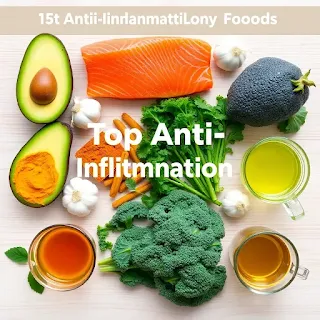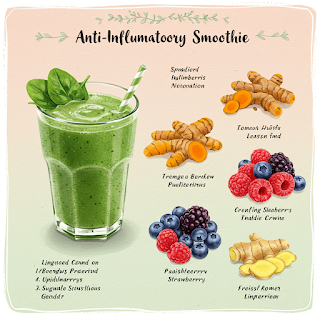Introduction:
What is Inflammation and Why Does it Matter?
Inflammation is a natural process in the body that occurs as part of the immune system's response to injury or infection. However, chronic inflammation can be harmful and is linked to a wide range of health issues, including autoimmune diseases, cardiovascular diseases, and diabetes. While acute inflammation (like when you have a cut or infection) is protective, chronic inflammation lingers long-term and contributes to the development of various chronic diseases.
Some common causes of chronic inflammation include poor diet, lack of physical activity, and stress. As more people become aware of these risks, anti-inflammatory diets have gained popularity as a way to help manage inflammation naturally.
How Anti-Inflammatory Foods Work
Certain foods have been shown to contain compounds that reduce inflammation at the cellular level. These include antioxidants, phytochemicals, omega-3 fatty acids, and polyphenols. For instance, omega-3 fatty acids found in fish and certain plant oils help reduce the production of inflammatory molecules. Similarly, antioxidants such as vitamins C and E, which are abundant in fruits and vegetables, help neutralize free radicals that contribute to inflammation.
Incorporating a variety of these foods can help lower the inflammatory markers in your body, leading to improved overall health and reduced risk of chronic diseases.
Top 10 Anti-Inflammatory Foods in 2025
1. Turmeric: The Golden Spice for Health
Turmeric, a bright yellow spice commonly used in Indian cuisine, contains curcumin, a compound with powerful anti-inflammatory properties. Studies have shown that curcumin can inhibit inflammatory pathways and has been linked to reduced symptoms in conditions like arthritis and chronic pain.
How to Use: Add turmeric to smoothies, curries, or even warm milk for a comforting drink.
2. Fatty Fish (Salmon, Mackerel, Sardines): Omega-3 Powerhouses
Fatty fish are rich in omega-3 fatty acids, which have been extensively studied for their anti-inflammatory effects. Omega-3s help reduce the production of pro-inflammatory compounds and promote heart health.
How to Use: Enjoy grilled salmon, mackerel, or sardines as part of a main dish or in salads.
3. Leafy Greens (Spinach, Kale, Swiss Chard): Nutrient-Dense Vegetables
Leafy greens are packed with vitamins, minerals, and antioxidants like vitamin K and folate, which help reduce inflammation. They're also low in calories, making them perfect for a healthy anti-inflammatory diet.
How to Use: Add spinach or kale to smoothies, sandwiches, or sauté them with garlic for a nutritious side dish.
4. Berries (Blueberries, Strawberries, Raspberries): Antioxidant-Rich Fruits
Berries are high in anthocyanins, powerful antioxidants that reduce inflammation. Consuming berries regularly has been associated with a reduced risk of chronic diseases like heart disease and diabetes.
How to Use: Add fresh or frozen berries to your oatmeal, yogurt, or salads.
5. Ginger: A Natural Anti-Inflammatory Root
Ginger contains bioactive compounds like gingerol, which have shown promise in reducing inflammation and alleviating pain. It’s commonly used in traditional medicine for its anti-inflammatory and digestive benefits.
How to Use: Incorporate ginger into teas, smoothies, or stir-fries.
6. Olive Oil: Heart-Healthy and Anti-Inflammatory
Extra virgin olive oil is rich in oleocanthal, a compound that mimics the effects of non-steroidal anti-inflammatory drugs (NSAIDs). It’s also packed with healthy fats that support heart health.
How to Use: Use olive oil as a dressing for salads, drizzle it over roasted vegetables, or incorporate it into cooking.
7. Nuts (Almonds, Walnuts): Healthy Fats and Antioxidants
Nuts, especially almonds and walnuts, are rich in vitamin E, healthy fats, and polyphenols that fight inflammation. They’re also great for heart health and can help manage weight.
How to Use: Snack on a handful of nuts or add them to salads and baked goods.
8. Avocado: Rich in Monounsaturated Fats
Avocados are a fantastic source of monounsaturated fats, which are known to reduce inflammation and improve cholesterol levels. They also contain fiber, which supports digestive health.
How to Use: Spread avocado on toast, add it to salads, or blend it into smoothies.
9. Garlic: A Flavorful Anti-Inflammatory Ingredient
Garlic contains allicin, a compound with potent anti-inflammatory properties. It has also been shown to improve immune function and lower the risk of heart disease.
How to Use: Add garlic to soups, stews, roasted vegetables, or use it as a seasoning in various dishes.
10. Green Tea: A Beverage Full of Anti-Inflammatory Compounds
Green tea is rich in catechins, antioxidants that help reduce inflammation and protect against oxidative stress. Drinking green tea regularly has been linked to improved metabolism and reduced inflammation.
How to Use: Enjoy a cup of green tea as a refreshing afternoon beverage or add it to smoothies.
How to Incorporate These Anti-Inflammatory Foods into Your Diet
Incorporating these anti-inflammatory foods into your diet doesn't have to be complicated. Here are some simple ideas:
Smoothies: Blend turmeric, ginger, berries, and leafy greens with some almond milk for a powerful anti-inflammatory drink.
Salads: Use spinach, kale, avocados, nuts, and olive oil for a nutrient-dense salad.
Main Dishes: Prepare grilled salmon or mackerel with a side of roasted vegetables drizzled with olive oil.
Other Lifestyle Tips for Reducing Inflammation
While diet plays a crucial role, other lifestyle factors can also help reduce inflammation:
Exercise: Regular physical activity can lower inflammation by improving circulation and immune function.
Sleep: Ensure you're getting enough rest, as poor sleep can increase inflammation.
Stress Management: Chronic stress leads to inflammation, so practices like meditation, yoga, and mindfulness can help reduce stress levels.
Conclusion
Reducing inflammation through your diet is one of the most effective ways to enhance your health and prevent chronic diseases. By incorporating the top 10 anti-inflammatory foods into your meals, you can take control of your health and support your immune system. Start small, and you'll soon notice the benefits of an anti-inflammatory diet in your overall well-being.
FAQ Section
Q1: Can anti-inflammatory foods help with joint pain?
Yes, anti-inflammatory foods like turmeric, ginger, and fatty fish have been shown to reduce joint pain and inflammation associated with conditions like arthritis.
Q2: How fast can I expect results from an anti-inflammatory diet?
While individual results vary, many people report feeling better within a few weeks of consistently incorporating anti-inflammatory foods into their diet.
Q3: Are there any foods I should avoid to reduce inflammation?
Foods high in refined sugars, processed foods, and trans fats can promote inflammation. It's best to limit these while focusing on whole, nutrient-dense foods.






Post a Comment